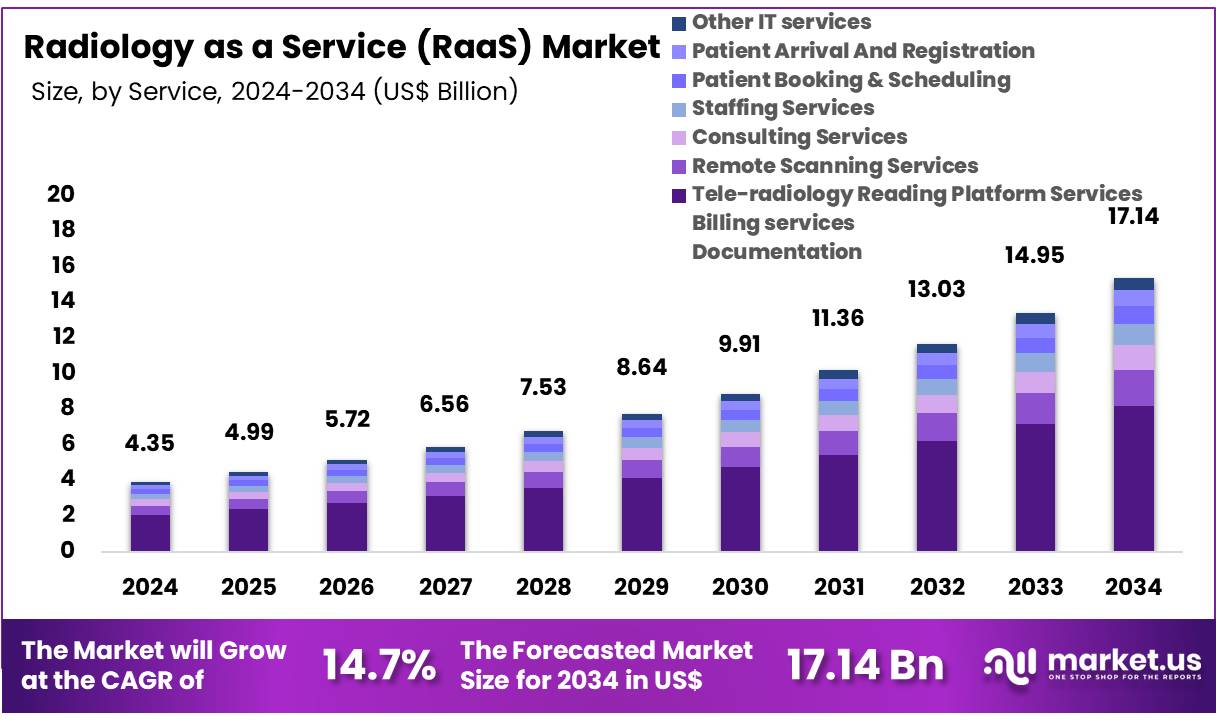The global Radiology as a Service (RaaS) market is projected to grow from US$ 4.35 billion in 2024 to around US$ 17.14 billion by 2034. This growth reflects a strong CAGR of 14.7% during the forecast period. In 2024, North America led the market with a 39.6% share, generating revenue of approximately US$ 1.72 billion. The growth is fueled by the need to expand access to medical imaging and streamline healthcare delivery through cloud-based technologies.
A key driver behind this expansion is the global demand for diagnostic imaging. According to the World Health Organization (WHO), tools like X-rays, CT scans, and MRIs are essential in diagnosing and managing diseases such as cancer, trauma, and stroke. However, many healthcare systems, especially in developing nations, lack enough radiologists. RaaS addresses this issue by offering remote, cloud-based imaging services, reducing the need for in-house infrastructure or on-site specialists.
The increasing prevalence of chronic diseases also contributes to market growth. The WHO reports that non-communicable diseases like heart disease, diabetes, and cancer cause 74% of global deaths. These conditions require regular medical imaging for monitoring and treatment planning. RaaS makes it easier for hospitals and clinics to access expert radiology services without large capital investment, helping lower costs while improving patient care.
Government support for digital health is further accelerating adoption. For instance, the U.S. Department of Health and Human Services promotes telehealth and cloud-based technologies to increase healthcare efficiency. In India, the Ministry of Health and Family Welfare has introduced the Ayushman Bharat Digital Mission, which includes cloud integration in healthcare. Such initiatives promote the use of RaaS in both urban and underserved regions, enabling wider access to radiology expertise.
Data privacy is another critical factor. Modern RaaS platforms are built to meet strict regulations like the U.S. HIPAA and the EU's GDPR. These frameworks ensure secure handling of patient data, helping build trust among healthcare providers. The ongoing shortage of qualified radiologists, noted by the UK’s NHS, also boosts the demand for RaaS. By connecting clinics with remote radiology experts, RaaS platforms close staffing gaps and speed up diagnostic services globally.

Key Takeaways
- In 2024, the Radiology as a Service (RaaS) market generated US$ 4.35 billion and is forecasted to hit US$ 17.14 billion by 2034.
- The market is growing steadily at a CAGR of 14.7%, showing strong momentum in digitized healthcare services and remote radiology demand.
- Among services, Tele-radiology Reading Platform Services dominated in 2023, capturing a substantial 47.8% share of the total RaaS service segment.
- The service segment includes Remote Scanning, Consulting, Staffing, Billing, Documentation, Scheduling, Registration, and other IT-related support functions.
- From a technology standpoint, Direct Digital Radiology held the lead with 58.2% market share, outpacing Computed Radiology systems in adoption and usage.
- Application-wise, Cardiovascular Imaging was the top contributor, commanding a 32.5% revenue share in the overall RaaS applications segment.
- Other major applications include Chest Imaging, Dental Imaging, Orthopedic Imaging, and various general diagnostic imaging categories.
- Hospitals led the RaaS end-use segment, making up 54.3% of the market due to their high patient volumes and advanced infrastructure.
- The end-use market also includes Diagnostic Imaging Centers, Radiology Clinics, Physician Offices, Nursing Homes, and other healthcare providers.
- North America remained the leading regional market, securing a dominant 39.6% share in 2023, driven by strong healthcare infrastructure and early tech adoption.
GET SAMPLE REPORT : https://market.us/report/radiology-as-a-service-raas-market/request-sample/
Regional Analysis
North America holds the largest share in the Radiology as a Service (RaaS) market, accounting for 39.6% of global revenue. This dominance is due to rapid advancements in medical imaging technology and strong demand for remote radiology solutions. The region's healthcare systems are adopting digital tools faster than ever. The need for efficient diagnosis and faster reporting also supports market growth. Remote services are especially in demand in rural and underserved areas where access to in-person radiologists is limited.
A critical growth driver is the ongoing shortage of radiologists in North America. According to projections, the U.S. may face a shortfall of 17,100 to 41,900 radiologists by 2030. This shortfall increases the reliance on tele-radiology and outsourced radiology services. Healthcare facilities are actively turning to cloud-based platforms and remote scanning services. These technologies offer flexibility, better resource utilization, and help meet rising diagnostic needs. As a result, remote diagnostic services are becoming an essential part of modern healthcare delivery.
Technological innovations are accelerating market growth. Artificial Intelligence (AI) is improving diagnostic speed and accuracy. Cloud-based imaging systems enable real-time sharing and analysis of medical images. These tools reduce turnaround times and improve collaboration among healthcare professionals. Moreover, digital storage and AI-based reading platforms support the growing workload in hospitals. Together, these advancements are streamlining workflows and boosting overall efficiency. The result is better patient care and optimized radiologist performance across the healthcare system.
However, the market also faces some challenges. Data security and patient privacy are major concerns. Compliance with regulations like HIPAA is essential for all RaaS providers. Additionally, high infrastructure costs can be a barrier for smaller healthcare centers. Despite this, North America's strong digital health infrastructure and favorable reimbursement policies support ongoing market expansion. Government efforts to promote telehealth services further strengthen this trend. As these drivers continue, North America is expected to maintain its lead in the RaaS market in the coming years.



